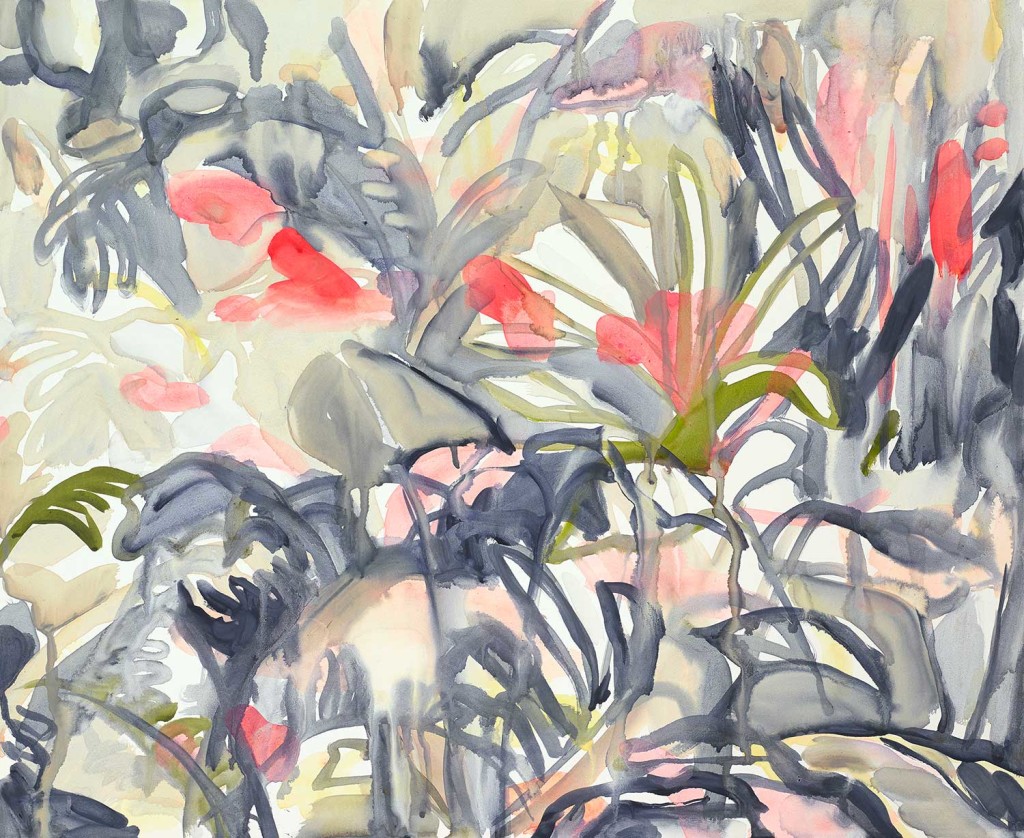
INTRODUCTION
– Ned Carter Miles.
Through exhibitions and residencies both in the UK and abroad, in recent years Tamsin Relly has developed an instantly recognisable oeuvre of deceptively simple paintings, drawings and monotypes that chart and challenge the changing state of the ecological landscape.
The artist’s works often constitute organic responses to environments whose own organic status is either under threat or artificial. Pieces from the “Jungle Snow” series (2014), include observations from zoos in different European and American cities, documenting habitats whose reconstruction in urban spaces is ironically necessitated by their erasure elsewhere. The pastel and watercolour “Circles in the Woods” series—created during a residency in Finland in 2016—sees raw black marks on untreated white paper reflect the increasingly erratic and unnatural thaw patterns in the region. A third series, “Imagining the Amazon” (2016), joyfully explores our desire to replicate floral and faunal exotica in everything from conservation to design, and yet the sometimes ghostly aesthetic of these water-soluble oil paintings also intimates the dual spectres of deforestation and climate change.
“Forest Memory” brings together these suggestive snapshots of changing environments with additional new works to create something larger than its constituent parts. In the far-from-natural space of the gallery, the densely vegetal, quasi-abstract images are hung in groups and without labels, evoking clusters of leaves that culminate in a whole organism and wider enquiry. While some pieces are framed, suggesting containment of the thick vegetation depicted within, elsewhere the subject is allowed to push right to the border it shares with the white wall, giving the impression not of fertile scenes trapped remotely behind the picture plane, but of plants blooming triumphantly into the otherwise intentionally sterile space. Even in its abstracted form — whether depicted in rich sylvan thickets of oil on linen and canvas, or sporadic bright pink blooms on gesso and aluminium — the sight of such greenery triggers an old comfort, tapping into the primeval forest memory whose roots run ineradicably deep in our collective psyche.
As in Relly’s earlier series and exhibitions, questions of authenticity and ecological shift arise here in subtle ways. The artificial oasis of the Las Vegas strip depicted in Flamingo Hotel (2016) and When Vegas Freezes Over (2014), for instance, is portrayed with a particularly muted palette—if these works appear like the fronds of a plant, some of them are intentionally withered.
Although conscious of global issues, the exhibition is neither alarmist nor explicitly didactic. Rather, it represents the organic growth of a long-running enquiry that, like any ecosystem, has its own naturally occurring balance. In several of the works, such as Green and Orange IV (2014), Rain Wall (2016) and the eponymous Forest Memory (2016), there is a subtle impression of symmetry, as if to suggest both image and reflection without indicating which is to be taken as a duplicate. Elsewhere, for each of Relly’s verdant synechdochical scenes, a sense is given of a mirror image either within the frame or existing elsewhere. Despite our instinctive response to the exhibition’s lush imagery, at this stage in the Anthropocene it comes with a sense of doubt, the nostalgic pang of a fading forest memory.
_______
Ned Carter Miles is a writer, critic, and photographer based in London.
He is London desk editor for Art Asia Pacific, and has also contributed to the Royal Academy Magazine, Apollo, the Art Newspaper, Aesthetica, This is Tomorrow, and ArtLyst. His fiction has been featured in the Ox Magazine (US), the Pinched (UK), and the Wrong Quarterly (UK).